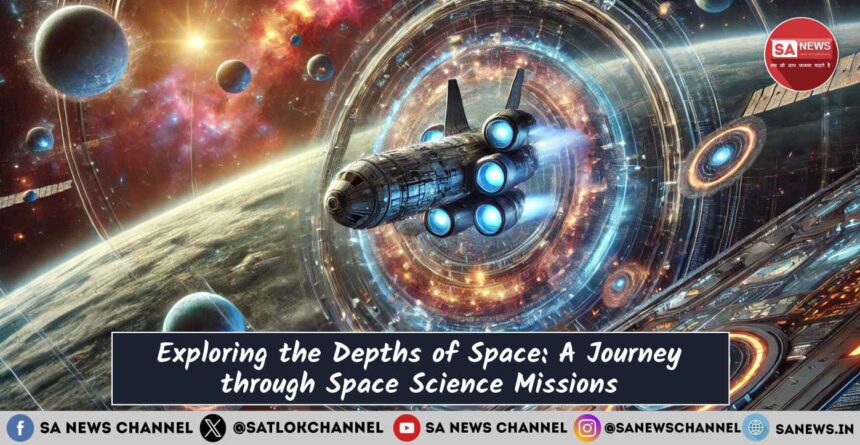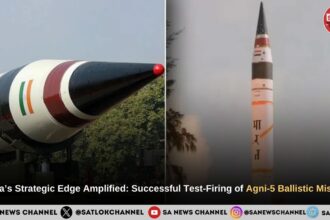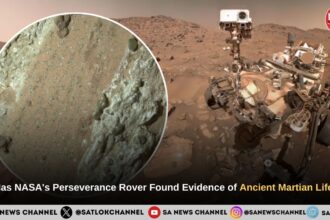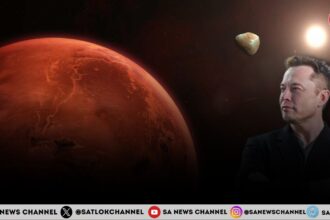Space Science Missions: In the vast expanse of the universe, space science missions play a crucial role in our quest to unravel the mysteries of the cosmos. From exploring distant planets to studying black holes and galaxies, these missions offer valuable insights into the workings of the universe. In this article, we will delve into the world of space science missions, exploring their significance, challenges, and achievements.
- The Importance of Space Science Missions
- What are the primary goals of space science missions?
- The Foundations of Space Science
- Challenges Faced by Space Science Missions
- Significant Achievements in Space Science
- The Emergence of Modern Astronomy
- The Identification of Galaxies
- The Advent of the Space Age
- Solar System Exploration
- What are some of the most significant achievements of space science missions?
- Future Prospects in Space Science
- The Origins of India’s Space Program
- Future Space Missions
- The Creation of the Universe: A Quest for Understanding
- FAQ related to Space Science
The Importance of Space Science Missions
- Space missions yield critical information regarding remote galaxies, planetary landscapes, and cosmic events, enhancing scientific comprehension of the universe’s origins and development.
- The creation of spacecraft and exploration instruments propels advancements in technology, particularly in materials science, robotics, and communication, which in turn benefits multiple sectors on Earth.
- Satellites deployed during space missions are essential for providing services such as GPS, satellite television, and internet access, facilitating effective global communication and navigation.
- Satellites are instrumental in observing weather trends, monitoring environmental shifts, and collecting data on natural disasters, which supports the understanding of climate change and improves disaster response strategies.
- The pursuit of space exploration motivates students to engage in STEM fields, promoting innovation and ensuring a continuous influx of skilled professionals into the workforce.
What are the primary goals of space science missions?
The primary goals of space science missions are to study the origins of the universe, the formation of galaxies, stars, and planets, and the search for extraterrestrial life. By collecting data from space, scientists can test theories, develop new technologies, and gain a deeper understanding of the cosmos.
The Foundations of Space Science
Space science includes various disciplines such as astronomy, physics, chemistry, and engineering, enhancing our understanding of the universe.
Astronomy and Astrophysics
Astronomy studies celestial bodies like stars and galaxies through light and radiation analysis. Astrophysics, a branch of astronomy, focuses on the physical properties and processes of these entities.
Cosmology
Cosmology explores the universe’s origin, evolution, structure, and fate, addressing key questions about the Big Bang, dark matter, and the universe’s large-scale configuration.
Planetary Science
Planetary science investigates planets, moons, and other celestial bodies, examining their formation, composition, dynamics, and the potential for extraterrestrial life.
Space Exploration and Engineering
Space exploration involves using spacecraft and technology to study space, including the development of rockets, satellites, and probes to gather data about the universe.
Challenges Faced by Space Science Missions
Despite their importance, space science missions are not without challenges.
- Space missions require advanced technology and precise engineering, facing risks from hardware failures, software issues, and launch delays. Overcoming these challenges demands extensive research, rigorous testing, and continuous innovation in the harsh conditions of space.
- The financial costs of space missions are significant, involving development, launch, and operational expenses. Securing funding from government, private, and international sources is challenging, with budget constraints potentially leading to delays or cancellations. Effective financial management and diverse funding sources are crucial for mission success.
- Space missions generate vast amounts of data that must be efficiently managed for processing, storage, and analysis. This requires reliable scientific instruments and advanced analytical techniques, including machine learning, to extract meaningful insights.
- International collaboration is essential in space missions, requiring coordination among nations and compliance with various regulations. While complex, these partnerships foster innovation and resource sharing, relying on effective communication and mutual agreements for success.
- The sustainability of space programs depends on ongoing public and political support. Clearly communicating the benefits of space exploration is vital for securing funding and maintaining interest, while public engagement through education and transparency fosters enthusiasm for missions.
What are some of the challenges faced by space scientists during missions?
Some of the challenges faced by space scientists during missions include ensuring the reliability of spacecraft systems, managing communication delays with missions that are far from Earth, and dealing with limited resources and funding. Overcoming these challenges requires collaboration, innovation, and a deep understanding of the complexities of space exploration.
Significant Achievements in Space Science
Over the last century, space science has achieved numerous pivotal milestones that have greatly enhanced our comprehension of the universe:
The Emergence of Modern Astronomy
The early 17th century saw the invention of the telescope, which transformed the field of astronomy. Galileo Galilei, a key figure in modern astronomy, utilized the telescope to examine the moons of Jupiter, the phases of Venus, and the lunar craters. These groundbreaking observations contested the geocentric model and bolstered the heliocentric theory put forth by Copernicus.
■ Also Read: History of Space Exploration: Time travel through the Space Explorations
The Identification of Galaxies
In the 1920s, Edwin Hubble revealed that the universe is far more expansive than previously believed. He identified that many of the so-called “nebulae” observed in the night sky were, in fact, galaxies situated beyond our Milky Way. Hubble’s findings also indicated that the universe is in a state of expansion, which contributed to the development of the Big Bang theory.
The Advent of the Space Age
The launch of Sputnik 1 by the Soviet Union in 1957 signified the dawn of the space age. This event was succeeded by several key milestones, including Yuri Gagarin becoming the first human in space in 1961, the historic Moon landing by Apollo 11 in 1969, and the establishment of space stations.
Solar System Exploration
Robotic missions have ventured to nearly all the planets within our solar system, yielding critical information regarding their composition, atmospheres, and potential for supporting life. Noteworthy missions include the Voyager probes, which have journeyed beyond the solar system, and the Mars rovers, which persist in their exploration of the Martian terrain.
What are some of the most significant achievements of space science missions?
Some of the most significant achievements of space science missions include the Voyager missions, which have reached interstellar space, the Hubble Space Telescope, which has revolutionized our understanding of the cosmos, and the Mars rovers, which have uncovered evidence of ancient water on the Red Planet. These missions have reshaped our view of the universe and laid the groundwork for future exploration.
- Hubble Space Telescope: Launched in 1990, it has enhanced our understanding of star and galaxy formation, dark matter, and the universe’s expansion.
- Chandra X-ray Observatory: Since 1999, it has focused on X-rays from high-energy phenomena like black holes.
- James Webb Space Telescope: Launched in December 2021, it observes infrared light to study star and galaxy formation, exoplanet atmospheres, and the early universe.
- Mars Exploration: Mars is a prime target for extraterrestrial life due to its Earth-like features. Robotic missions like Curiosity and Perseverance are searching for signs of life, bolstered by the presence of subsurface liquid water.
- Europa and Enceladus: Jupiter’s moon Europa and Saturn’s moon Enceladus are promising candidates for life because of their subsurface oceans. Upcoming missions, including NASA’s Europa Clipper and ESA’s JUICE, will further explore these moons.
- Exoplanets and the Habitable Zone: The search for life beyond our solar system has grown with the discovery of exoplanets in the habitable zone, where liquid water may exist. The Kepler Space Telescope has identified thousands of such planets, with future missions like the James Webb Space Telescope and PLATO set to investigate them.
Future Prospects in Space Science
The realm of space science is poised for remarkable advancements. Innovations in technology and enhanced international cooperation are set to elevate space exploration and scientific inquiry to unprecedented levels:
Artemis Program
NASA’s Artemis initiative is designed to facilitate the return of humans to the Moon by 2024, with aspirations to establish a sustainable human presence by 2028. This initiative will also act as a precursor for future manned missions to Mars.
Mars Colonization
The concept of establishing a human presence on Mars has garnered considerable interest in recent years. Organizations such as SpaceX, under the leadership of Elon Musk, are working on the necessary technologies to transport humans to Mars and create self-sustaining colonies. These initiatives could significantly contribute to humanity’s expansion beyond Earth.
Asteroid Mining
Asteroids are rich in valuable minerals and resources that can be extracted for various applications. Companies like Planetary Resources and Deep Space Industries are investigating the feasibility of asteroid mining, which has the potential to transform resource extraction and utilization.
Interstellar Exploration
Although it remains largely within the domain of science fiction, the notion of interstellar exploration presents an exhilarating possibility. Initiatives such as Breakthrough Starshot are focused on developing the technology required to dispatch small spacecraft to the nearest star systems, thereby enabling the exploration of distant celestial bodies.
The Origins of India’s Space Program
The inception of India’s space program can be traced back to the formation of the Indian National Committee for Space Research (INCOSPAR) in 1962, spearheaded by Dr. Vikram Sarabhai. Acknowledging the significance of space technology for the advancement of the nation, INCOSPAR established the Thumba Equatorial Rocket Launching Station (TERLS) in Kerala. The successful launch of the first sounding rocket from TERLS in 1963 signified India’s foray into the realm of space research.
- Launched on April 19, 1975, Aryabhata was India’s first satellite, developed by ISRO and named after an ancient mathematician. It was sent into orbit via a Soviet Kosmos-3M rocket to gain satellite operation expertise, providing valuable data despite technical challenges.
- The Rohini satellite series, operational from 1980 to 1994, included four Earth observation satellites, starting with Rohini-1 on July 18, 1980, launched by India’s SLV-3. This series showcased India’s satellite design and launch capabilities, laying the groundwork for future projects.
- The Indian National Satellite System (INSAT), initiated in 1983, transformed telecommunications, broadcasting, and meteorology in India. The first satellite, INSAT-1B, launched on August 30, 1983, significantly improved communication services and expanded television and radio access.
- The Indian Remote Sensing (IRS) program began in 1988 with IRS-1A, enhancing Earth observation capabilities. These satellites provide crucial data for agriculture, forestry, water management, and urban development, with Cartosat-3 in 2019 noted for its high-resolution imaging.
- Chandrayaan-1, launched on October 22, 2008, was India’s first lunar mission, weighing 1,380 kg. It successfully detected water molecules on the Moon, gaining international recognition for India’s lunar research contributions.
- The Mars Orbiter Mission (Mangalyaan), launched on November 5, 2013, marked India’s first interplanetary exploration. It entered Mars’ orbit on September 24, 2014, making India the first nation to do so on its first attempt, providing valuable insights into Mars’ surface and atmosphere.
- Astrosat, launched on September 28, 2015, is India’s first multi-wavelength space observatory, capable of observing celestial phenomena in X-rays, ultraviolet, and optical wavelengths, contributing to significant discoveries in the universe.
- Following Chandrayaan-1, ISRO launched Chandrayaan-2 on July 22, 2019, to explore the Moon’s south pole. The mission included an orbiter, lander (Vikram), and rover (Pragyan). While the lander failed to land softly, the orbiter continued to provide valuable lunar data.
- Gaganyaan is India’s ambitious manned space mission, aiming to send Indian astronauts into space by 2023. Announced in 2018, it seeks to enhance India’s human spaceflight capabilities.
Future Space Missions
The Indian Space Research Organisation (ISRO) has an ambitious array of future missions that are set to expand the horizons of space exploration. Among the significant upcoming missions are:
A. Chandrayaan-3: This mission serves as a continuation of Chandrayaan-2, with the objective of achieving a successful soft landing on the lunar surface.
B. Shukrayaan-1: This proposed mission aims to explore Venus, concentrating on its atmospheric conditions and surface characteristics.
C. Mangalyaan-2: Following the achievements of Mangalyaan, this mission intends to perform more sophisticated investigations of Mars.
D. Exoplanet Mission: This proposed initiative seeks to examine exoplanets and identify potential habitable environments beyond our solar system.
In conclusion, space science missions are a testament to human ingenuity, curiosity, and determination. By venturing into the depths of space, we continue to push the boundaries of knowledge and explore the wonders of the cosmos. As we look to the future, let us continue to support and celebrate the remarkable achievements of space science missions, which have forever changed our understanding of the universe.
The Creation of the Universe: A Quest for Understanding
The origin of the universe has been a subject of profound contemplation and debate across cultures and epochs. The questions of who is responsible for the universe’s formation and what power sustains it touch the very essence of existence and our place within it.
Scientific Explanations
Scientific inquiry has made significant strides in explaining the physical processes that govern the universe. Theories such as the Big Bang suggest that the Earth, the Sun, and all celestial bodies originated from chaotic gases and energy, evolving over billions of years into the structured universe we inhabit today. However, these explanations often leave a void when addressing the “why” behind creation, an aspect many find deeply unsatisfying.
Religious Narratives
Various religious traditions offer their own narratives of creation, each imbued with cultural significance and spiritual meaning:
- Hinduism: Followers attribute creation to deities like Brahma, Vishnu, Shiva, and Goddess Durga. These figures represent the mechanics of creation and the cyclical nature of existence, emphasizing interconnectedness.
- Islam and Christianity: These traditions view Allah and God as the supreme architects of the universe. Creation is seen as an intentional act of divine will, providing purpose and meaning. Sacred texts guide believers in understanding their relationship with the creator and the moral framework for living.
Challenges of Interpretation
The proliferation of pseudo-religious leaders and local traditions can complicate the quest for understanding. Many devotees, influenced by charismatic figures prioritizing cultural narratives over universal truths, find themselves unaware of the ultimate reality and the true creator of all existence. This leads to a fragmented understanding of spirituality, where the essence of creation is obscured by dogma.
The Role of Enlightened Sages
In this context, the role of a genuinely enlightened sage becomes paramount. Such figures draw wisdom from multiple religious texts and philosophical traditions, bridging the gap between science and spirituality. They synthesize insights from various sources, offering a comprehensive understanding of the universe’s creation.
To know more do visit Sant Rampal ji maharaj Youtube Channel.
FAQ related to Space Science
Question: Who is the father of Indian space?
Answer: Vikram Ambalal Sarabhai
Question: Where is the headquarter of ISRO?
Answer: Antariksh Bhavan in Bangalore
Question: Is there oxygen in space?
Answer: No
Question: Can fire burn in space?
Answer: No, due to absence of Oxygen.
Question: what is gaganyaan mission
Answer: India’s inaugural human spaceflight initiative is being spearheaded by the Indian Space Research Organisation (ISRO).









